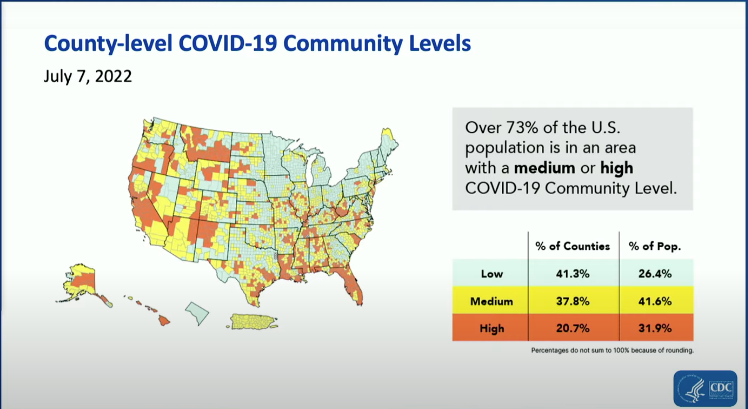Article
White House updates strategy to manage BA.5 variant of COVID-19 virus
Author(s):
Health agency leaders say tools are in place and deaths are preventable.

Vaccines, tests and masks all are part of the continuing strategy to manage the BA.5 subvariant of COVID-19 as the pandemic goes on, according to the administration of President Joe Biden.
On July 12, the White House announced its strategy to handle BA.4 and BA.5, subvariants of the Omicron variant that now make up 70% to 80% of COVID-19 cases in the United States.
The administration has been “clear eyed’ about the possibility of COVID-19 variants causing new waves of illness, Ashish Jha, MD, MPH, White House COVID-19 response coordinator, said in an online press conference on July 12.
“We have been watching this virus evolve rapidly,” Jha said. “We've been planning and preparing for this moment. And the message that I want to get across to the American people is this: BA.5 is something we're closely monitoring and most importantly, we know how to manage it.”
Jha spoke with Rochelle P. Walensky, MD, MPH, director of the Centers for Disease Control and Prevention, and Anthony S. Fauci, MD, director of the National Institute of Allergy and Infections Diseases in the National Institutes of Health.
The situation now is different from January 2021, when the nation had limited tools to combat the virus, according to the White House.
“More than 222 million Americans are fully vaccinated, over 106 million people have at least their first booster shot, and virtually every American of every age is eligible for vaccination,” the strategy fact sheet said. “To confront BA.5, the Administration will continue mobilizing the full strength and capabilities of the federal government and working with state and local leaders, health care workers, the private sector, and community- and faith-based organizations to ensure that the American people have easy and convenient access to and use vaccines, tests, and treatments.”
Jha repeated that point, emphasizing most COVID-19 deaths now are preventable and it is unacceptable to have a daily rate of 300 to 350 deaths from the disease. Hospitalization rates of about 5,100 people a day is double the hospitalization rate of early May, Walensky said.
Fauci used an illustration of the SARS-CoV-2 “family tree” to show how the Omicron variant has been particularly problematic because of its multiple sublineages. BA.5 has a growth advantage compared to earlier Omicron variants and substantially evades antibodies from vaccines and infection, but vaccines remain effective in reducing severe effects and death, he said.
Public health emergency
The federal experts and the White House fact sheet did not explicitly mention continuation of the public health emergency (PHE) declared for the pandemic.
The Department of Health and Human Services had a deadline of May 16 to notify the public that the PHE would end in 60 days. But that deadline came and went with no formal announcement, so the PHE is expected to last beyond July 16, but how long is unknown.
The American Academy of Family Physicians has suggested the PHE continue at least through the end of 2022, and publish a plan outlining what will change when it ends. That plan should have a public comment period of at least 60 days and should work with other federal departments, such as Treasury and Labor, to minimize disruptions and address gaps in health care coverage and access.
What do to next
According to the federal experts and the White House’s strategy fact sheet, elements of the strategy include:
- Making vaccines and boosters available.
Vaccines are free at 90,000 locations nationwide and anyone aged 5 years and older should receive a booster shot five months after the primary series. People age 50 and older or those who are moderately or severely immunocompromised should get a second booster at least four months after the first.
“If you haven’t, don’t delay, do it now,” Jha said. Getting vaccinated now will not preclude people from getting a variant-specific vaccine in fall or winter, he said.
For anyone age 50 or older, anyone who has not gotten a vaccine shot in 2022 should get one, Jha said. “It could save your life,” he said.
- Making COVID-19 treatment available and raising patient awareness.
The administration has purchased 20 million treatment courses – more than any other country – of Paxlovid, the oral antiviral that can reduce risk of hospitalization and death by about 90%. The drugs are available at more than 41,000 locations nationwide and almost 90% of people live within five miles of a place to get a prescription, according to the White House.
The response plan recommends anyone who tests positive for COVID-19 should consult their health care provider or visit COVID.gov to find a Test to Treat location for testing and prescriptions.
- Making tests available.
People should use home-based tests before attending large indoor gatherings, traveling or visiting indoors with immunocompromised people. There are 17 over-the-counter, at-home rapid tests and the administration has delivered about 530 million tests to 75 million households for free through COVIDtests.gov.
Medicare, Medicaid and private insurers must cover costs of eight free tests per person per month, available through local pharmacies and online, and there are 15,000 federally supported free testing sites across the nation.
- Consider wearing a mask.
The administration suggested consulting the CDC’s COVID-19 Community Levels map for recommendations on when to consider masking in indoor public spaces. High-quality masks are available and people should follow the CDC guidelines for masking.
- Encourage building owners to improve indoor ventilation.
The administration noted opening windows and using ventilation system filters and portable air cleaners can reduce the presence of virus particles in the air at home. The methods can make “an enormous difference” in reducing infections and spread, so businesses, schools and any institutions that bring people indoors should work to improve indoor air quality, Jha said.
Vaccines coming
A day before the White House briefing, HHS announced it has secured 3.2 million doses of the Novavax COVID-19 vaccine.
HHS announced the vaccine will be available free to states, jurisdictions, federal pharmacy partners, and federally qualified health centers if it receives emergency use authorization (EUA) by the U.S. Food and Drug Administration and recommendation from the Centers for Disease Control and Prevention. Novavax is expected to complete necessary quality testing in coming weeks and the government will take delivery upon completion.
The HHS announcement did not include information on vaccine availability for primary care physicians.





